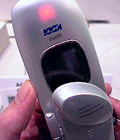Vodafone's ex-CEO: The Pre-Postmortem
The news out of Vodafone today is that Darryl E. Green, CEO of both Vodafone KK and Vodafone Holdings KK, has resigned for personal reasons. An interim CEO has been appointed while the companies search for a permanent replacement. Green’s departure is not unrelated, we suspect, to Vodafone’s recent grim Japanese financial results. While it’s too early for a full postmortem, it might help bring perspective to the situation to point out a number of successes that Vodafone achieved on Green’s watch.


 Today we look at some of the highlights from NTT DoCoMo’s 1 June 2004 press conference announcing the release of three new 3G cellphone each of which includes new functionality not seen before in the Japan market. This press event is typical for a new handset announcement; all three of Japan’s major cellcos (NTT DoCoMo, KDDI, Vodafone) conduct similar sessions for their new model releases. Today’s models all make the first FOMA handsets released back in late 2001 look fatter, clunkier, and more awful than ever. The battery life issues have been solved, and these sleek clam-shell beauties are more sophisticated than ever before.
Today we look at some of the highlights from NTT DoCoMo’s 1 June 2004 press conference announcing the release of three new 3G cellphone each of which includes new functionality not seen before in the Japan market. This press event is typical for a new handset announcement; all three of Japan’s major cellcos (NTT DoCoMo, KDDI, Vodafone) conduct similar sessions for their new model releases. Today’s models all make the first FOMA handsets released back in late 2001 look fatter, clunkier, and more awful than ever. The battery life issues have been solved, and these sleek clam-shell beauties are more sophisticated than ever before.